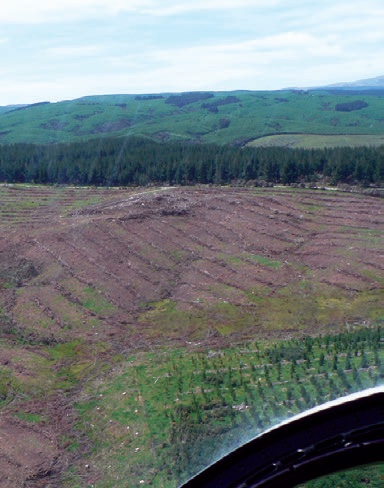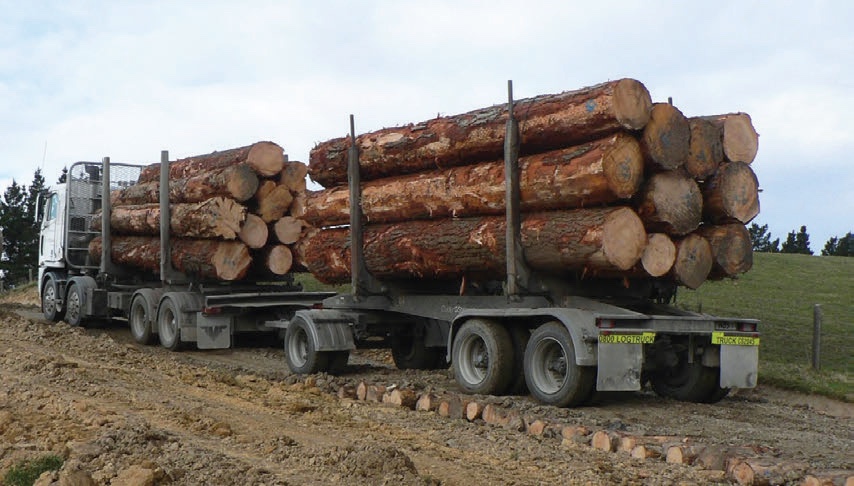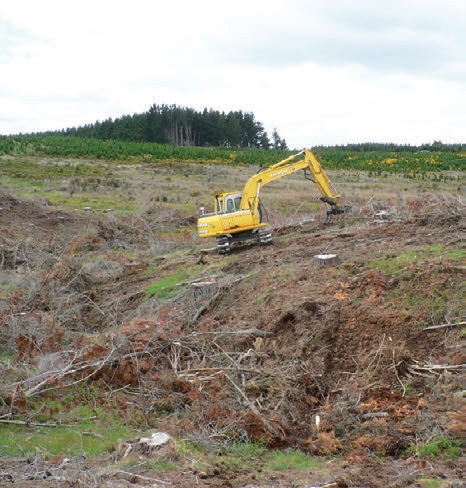After the harvest
Graeme Flett, New Zealand Tree Grower November 2013.
Congratulations. You have waited a long time for your harvest, but before you go off to spend the profits there are some things to consider.
The first is what the contract says. It depends on the contract you have with the buyer or agent as to how much reinstatement of your land, fences and tracks will be undertaken by the loggers or buyer. Usually this is not a lot. Many contracts will state that all the logging site waste will be left within the forest. This could be a very large heap or disposed of in a gully, but it must be kept out of waterways. In my view it is unwise to use fire to clear slash. Spontaneous combustion can set large heaps on fire and they can smoulder for months undetected.
Fire is a wonderful tool, but a horrific master, so keep a close eye on those heaps. It is better to have an area unplanted because of a heap of waste than a spreading fire. Another alternative is to give the wood away to a firewood merchant, or find someone who has a mobile chipper or shredder to convert it to boiler fuel or dairy wintering pad material.
Re-establishment
If you have used ground-based equipment to harvest, then windrowing of the slash is inevitable. Bulldozers have a habit of taking good topsoil away and their use should be avoided. A digger with a rake makes a much better job and a skilled operator leaves the topsoil behind. This applies to the fence line reinstatement as well, and if the operator has the necessary attachments such as drills, vibrator or driver, the fence will be up in no time. If you have used a cable logger then the site may need little or no ground preparation for the next crop to be planted.

If gorse or broom has been present before harvest it will be much thicker after harvest. Sowing grass seed across the windrowed area will reduce the weed spread. If you want to knock out known gorse or broom infestation, then take care with herbicide selection as certain sprays will also kill tree seedlings for some time. Get expert advice about withholding periods.
If the skid site is on the paddock, then plan to re-establish the pasture or perhaps sow a winter or summer crop. Re-establishing the crop should be left for at least a year. The ground will be very dry from the harvested crop, so let the ground soak moisture for a while.
Another problem which may be present is the pine bark beetle Hylastes ater. This beetle sucks sap from the cambium layer of newly harvested slash and will then move on to newly planted seedlings. Again, leave the area unplanted for a year. A larger stem diameter also stands beetle attack better.
There are no insecticides available for control, but some systemic insecticides can be used with the spot spray chemical if you consider a high risk of damage. We have also found that where we mounded the ground to help seedling establishment in frost pockets, the bare mineral soil which was exposed reduced or eliminated beetle attack.
The great news is the new crop will grow much better than the first rotation, especially for Douglas fir and radiata pine. The appropriate mycorrhizae will be present, and the genetics have improved considerably over the past 30 to 50 years since the first crop was planted.

Land use and the ETS
If you want to change the land use, or your family are away doing their own thing and are not interested in carrying on, it could be very wise when contemplating selling to leave the property as unencumbered as possible. This means no carbon credits to be paid back.
Remember that under the Emissions Trading Scheme, for de-foresting forests planted before 1990, you will have to pay back all the carbon credits in your forest even though you may have received none or the few that the government handed out. These pre-1990 credits from the government are treated as capital and not taxed if sold. You can de-forest up to two hectares in any five-year period.

If your trees were planted after 1989 you need to produce carbon credits up to the level allocated to you. If none have been allocated then no liability exists. If carrying on with trees in the ground remember that you have to re-plant any pre-1990 forest so that there is a minimum of 500 trees per hectare at four years from harvest and 30 per cent crown cover by year 10. Now is the time to buy cheap credits to top up if land use change or ownership change is on your agenda and you sold carbon credits. You should make sure that you get expert advice on your Emissions Trading Scheme obligations.
Income tax and the value
Once you have banked the cheque you need to consider the tax implications. As with farming, forestry income can be spread over the current year and the three previous years. If the property was purchased with trees on it, then in the sale and purchase agreement you should have had the separate value of any woodlots.
This value can be deducted from the sale as it could not be deducted at the time of purchase. This is considered a capital purchase, usually referred to ‘as cost of bush’. If that did not happen you might still be able to get a retrospective value, so see your accountant or forest advisor. You can also use the income equalisation account to soften the tax bill.
If you are like me, and want to analyse and compare the results of several harvests, here is a simple way to do it −
- Take the figure paid to you less GST
- Divide by the number of hectares
- Divide by the age of the harvested stand.
- This will give you a return per hectare per year.
You may want to refine it further by using the current return for your grades across all your sales and then taking off all the costs of seedlings, planting, blanking, pruning, thinning rates and so on for the whole rotation all at today’s prices and costs. This can be very enlightening and allows you to make comparisons with your farm returns.
Evaluate what has happened
This is the crux of your forestry operation. You may be able to pass on to others your mistakes and remedies, along with your successes, so that they can learn. This is an advantage of being a member of the New Zealand Farm Forestry Association and a Farm Forestry Discussion Group where these matters are shared. Ask yourself some or all of these questions −
- Did you have poor seedling survival because of poor handling before planting?
- Did you get enough trees established in your stand and was there poor planting with poor root form?
- Did the weeds beat you?
- Was the silviculture on time and was the knotty core within the 15 centimetre measure as seen in pruned butts sawn and peeled?
- Did you leave the harvest long enough to get the maximum volume, remembering that most of us get only one bite at the cherry per stand?
- Did you market the stand at the time of best dollar value?
- Did you sell overall by grade, tonne or block sale, remembering that sales by grade means you get paid for what you have produced?
- Did the roading into your forestry block stand up to the logging traffic and will it be of use for farm access?
To find out if you are likely to get a good price, keep an eye on the prices as published in the Tree Grower. Alternatively look at www.fridayoffcuts.co.nz for monthly updates and what is happening around the world.
On the roading question, we find that where tracks are formed two years or more in advance and the subsoil is allowed to dry, these roads stand up much better. Skid sites with a thick layer of heavy rock can be moved to another site and reused with the resulting savings in cost of transport.
You may want to re-plant the block, retire and buy a house, to move off the land, set up a son or daughter, or have a good holiday. You will have earned it. As a longer term investment, re-planting on a site with good access may be a wise choice. This can keep the forestry investment going for your grandchildren and longer.
Graeme Flett is a past President of the NZFFA and his family’s forests are based in South Otago.

 Farm Forestry New Zealand
Farm Forestry New Zealand